Newidiadau a pharhad bwyd yng Ngorllewin Cymru
gan Pat Caplan
Crynodeb
Mae astudio bwyd yn ffordd o ddysgu am gymaint o faterion eraill: hanes, ffermio, hunaniaeth, gwleidyddiaeth a pholisïau. Gall ddatgelu amrywiaeth eang o flasau a sut y mae’r rhain wedi newid dros y blynyddoedd. Yng ngorllewin Cymru, mae’r arfer o gynhyrchu a bwyta bwyd wedi newid llawer dros y 75 mlynedd diwethaf, ac er mwyn deall pam y mae pobl yn bwyta bwydydd penodol, mae angen i ni ystyried cefndiroedd a chylchoedd oes pobl, yn ogystal â chartrefi, marchnadoedd, siopau bwyd, bwytai a chaffis. Yr hyn sy’n parhau’n hanfodol bwysig yw bod bwyd yn rhywbeth cymdeithasol a diwylliannol. Mae’n cysylltu pobl trwy rannu a bwyta gyda’i gilydd, gan gynnwys yn rhan o ddathliadau tymhorol. Felly mae ein bwyd yn datgelu llawer am bwy yr ydym ni!
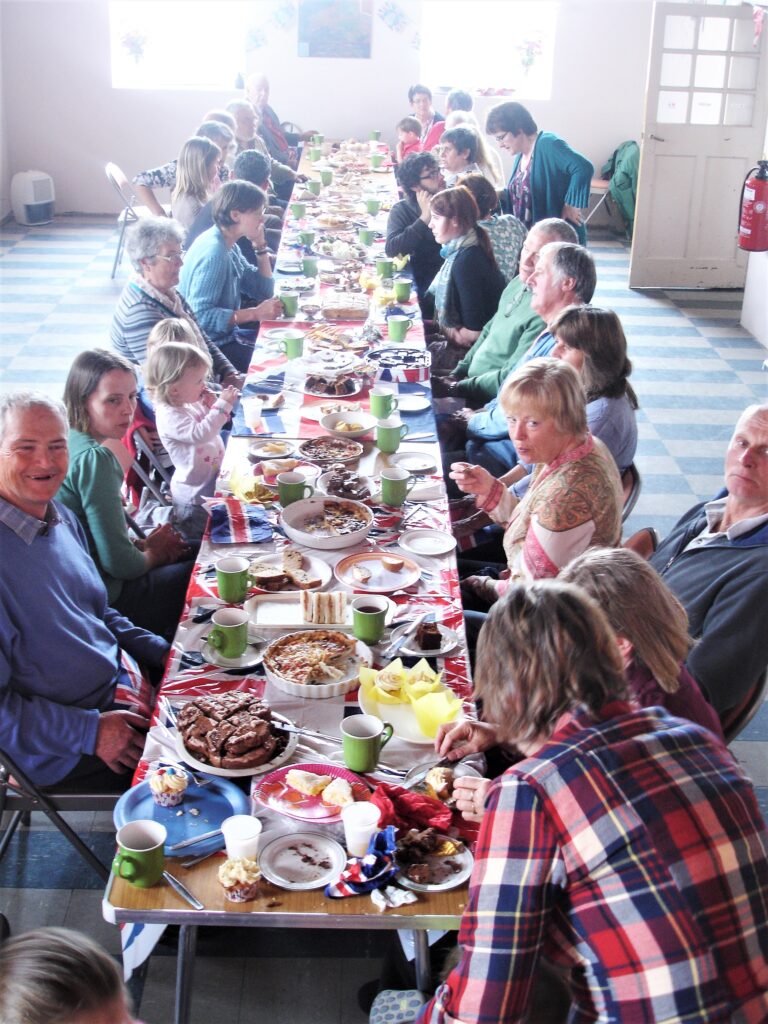
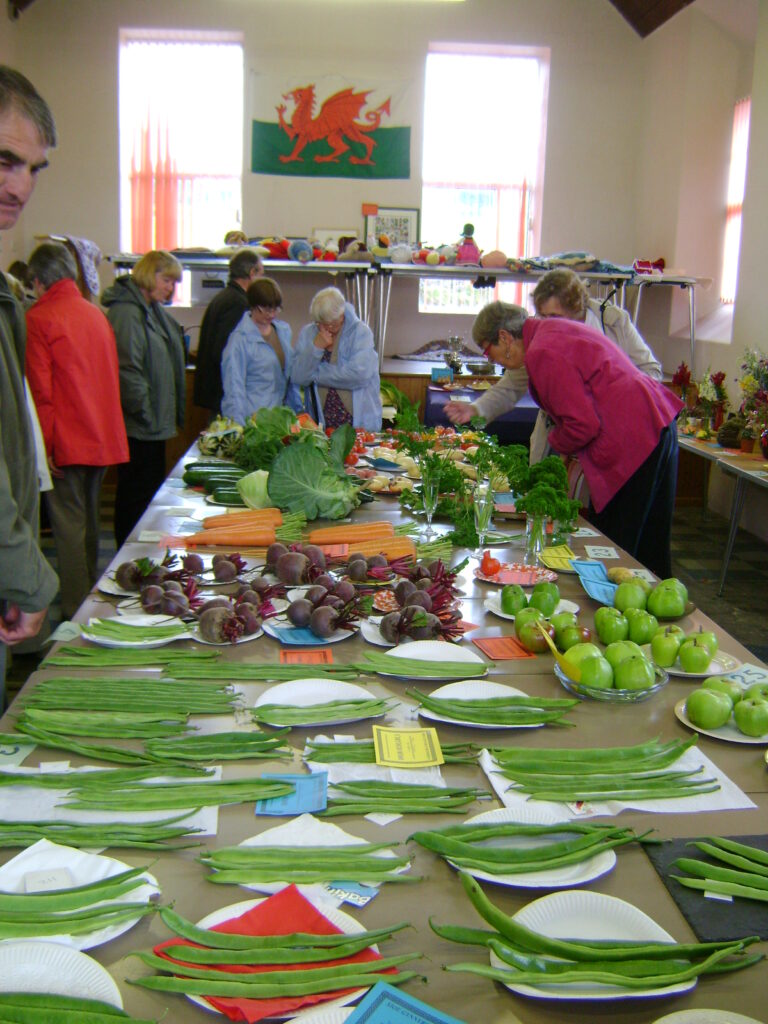
Yr Ail Ryfel Byd hyd at yr 1960au
Beth oedd pobl yn ei fwyta yn ystod y cyfnod hwn?
Tato oedd un o’r prif gnydau (ac maent yn parhau i fod), ac roedd ‘tato cynnar Sir Benfro’ yn ffefryn amlwg. Er hyn, roedd barlys a cheirch hefyd yn bwysig iawn yn ystod y cyfnod hwn. Y prif fath o gig oedd porc, a byddai aelwydydd na fyddent yn ffermio yn cadw mochyn neu ddau hefyd. Byddai’r rhain yn cael eu lladd bob hydref a’r cig yn cael ei halltu ac ystlysau’r moch yn cael eu hongian i’w mygu mewn simnai fawr. Gellir gweld y simnai fawr hyd heddiw yn rhai o fythynnod hynaf yr ardal. Cyn i’r clefyd mycsomatosis ddatblygu, byddai pobl yn dal ac yn bwyta cwningod gwyllt, ynghyd â’u hanfon ar y trên i Lundain. Mewn cyfnodau o gyni, yn enwedig yn ystod cyfnod y rhyfel, efallai y byddai rhai pobl yn troi at wylanod, drudwy, ydfrain a sguthanod, yn ôl yr hyn a ddatgelwyd mewn cyfweliadau â thrigolion hŷn yn ystod yr 1990au.

Beth fyddai pobl yn ei goginio, a sut?
Roedd y gegin yn bwysig iawn mewn cartrefi Cymreig. Byddai’r gegin fel arfer yn cynnwys grât, a fyddai’n cynnwys planc neu gradell, y gellid eu defnyddio i wneud crempogau, picau ar y maen (a elwir hefyd yn bice bach, cacennau cri neu deisennau gradell). Mae sawl rysáit ar gael ar y We, ond dyma un a gasglwyd gan Minwell Tibbott a fu’n gweithio yn Amgueddfa Werin Cymru, Sain Ffagan (gweler y rysáit isod – dolen). Yn 1974, teithiodd o gwmpas gorllewin Cymru yn casglu ryseitiau a chyhoeddi’r clasur, sef Welsh Fare: a collection of recipes.
Yn ystod y cyfnod hwn, byddai nifer o gartrefi yn pobi eu bara eu hunain hefyd gan ddefnyddio’r ffwrn ar y grât neu ffwrn yn y wal ar ochr y simnai fawr. Byddai rhai hefyd yn defnyddio’r gradell i wneud bara planc a bara brith. Roedd yn bwysig iawn i sicrhau bod bwydydd o’r fath ar gael wrth law bob amser i’w cynnig i ymwelwyr.
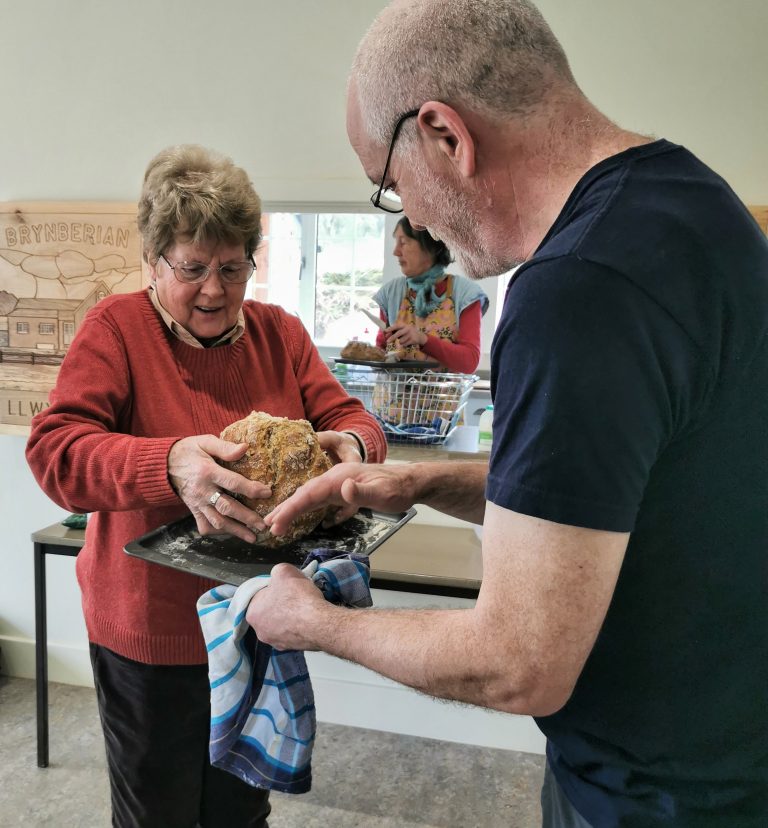
Pryd pwysig iawn oedd y cawl, sef pryd un potyn o sŵp trwchus, llysiau a bacwn. Gellid coginio hwn ar y grât. Byddai symiau mawr o gawl yn cael eu paratoi ar ffermydd adeg digwyddiadau pwysig, er enghraifft adeg y cneifio a’r cynaeafu.
Dyma rai enghreifftiau ar gyfer cawl – cawl â chig a chawl llysieuol (cliciwch yma ar gyfer y ryseitiau)
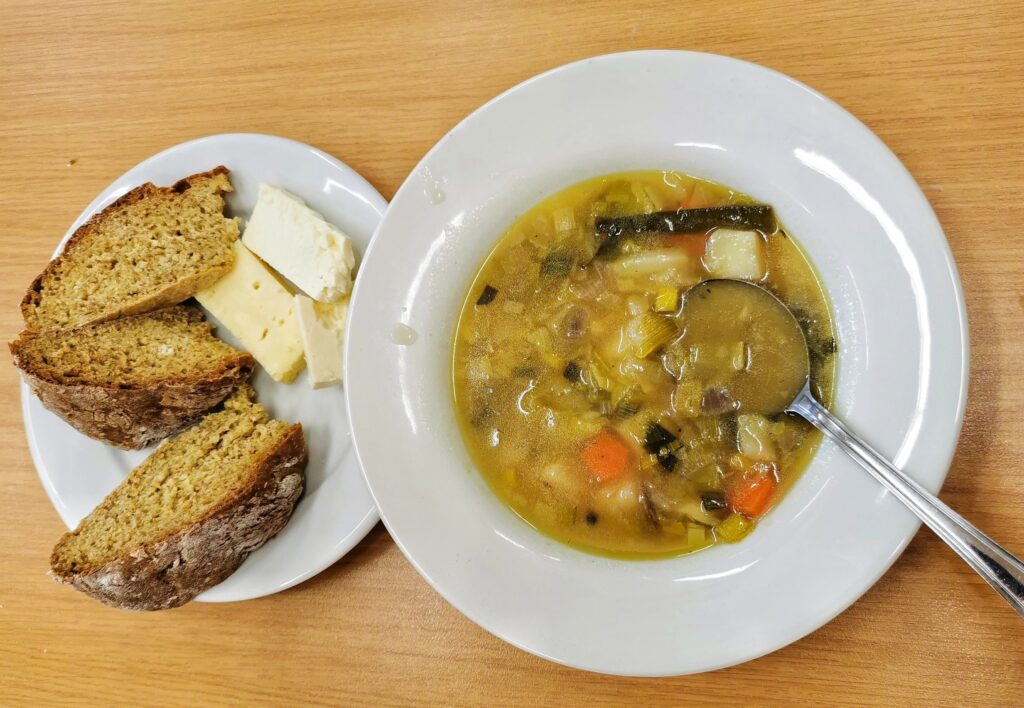
Byddai rhai cartrefi hefyd yn gwneud eu diodydd eu hunain. Un o’r rhain oedd cwrw lleol o’r enw macsi. (dolen: Darllenwch ddarn o gyfweliad am sut y mae gwneud macsi yn 1995)
Roedd yna hefyd ddiodydd dialcohol eraill y gellid eu gwneud o’r cartref, er enghraifft cwrw dant y llew a chwrw dynad neu gordial blodau’r ysgaw y byddent yn ei roi i’r plant.
O ble y byddai pobl yn cael eu bwyd?
Byddai gan lawer o’r teuluoedd ychydig o dir neu ardd lle byddent yn tyfu llysiau, ynghyd â chadw ieir a mochyn neu ddau. Byddai’r rhan fwyaf o’r ffermydd yn cynhyrchu eu llaeth eu hunain a byddai ffermydd godro masnachol, a oedd yn meddu ar fuches fwy, yn rhoi eu llaeth mewn buddai a fyddai’n cael ei chasglu ar gert a cheffyl yn gynnar yn ystod y cyfnod hwn, cyn i’r lorïau ddod wedi hynny.
Byddai cynaeafu yn bwysig iawn hefyd, gan gynnwys casglu mwyar gwyllt, er enghraifft mwyar duon a llus duon bach. Ar yr arfordir, byddai modd casglu, coginio a bwyta bara lawr hefyd (math o wymon).
Roedd yna siopau lleol yn y pentref ei hun ac mewn trefi cyfagos, er enghraifft Trefdraeth a Chrymych, ac roedd yna faniau teithiol, gan gynnwys y becws. Roedd pentref Nanhyfer yn arbenigo mewn tyfu afalau a byddent yn eu cyflenwi i bentrefi cyfagos. Roedd gan rai ardaloedd farchnadoedd wythnosol.
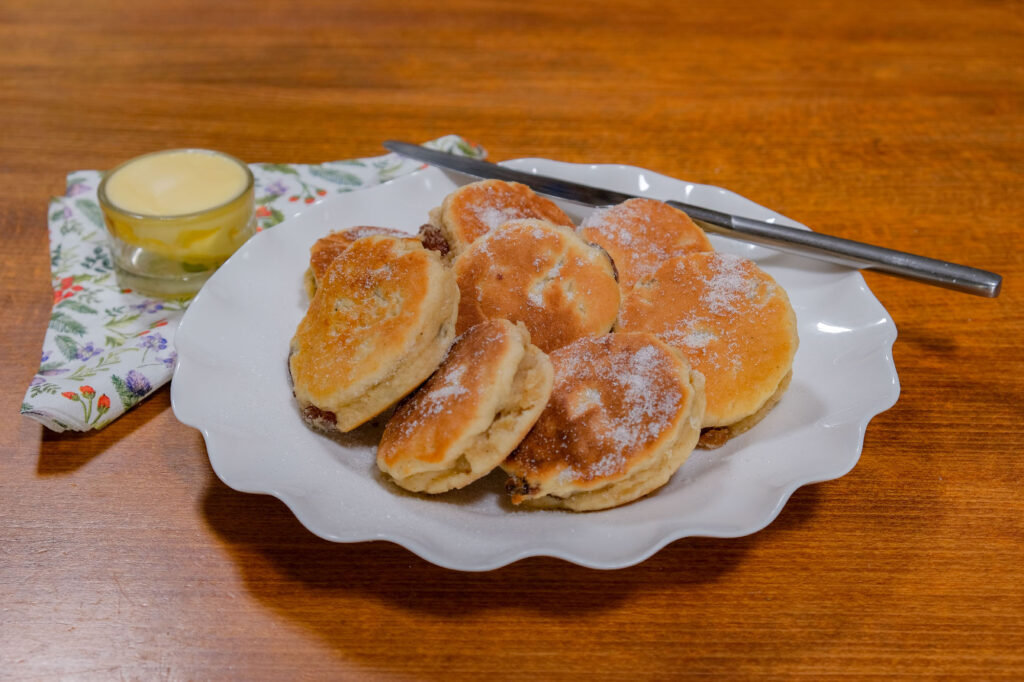
1970s-2000
Erbyn diwedd yr 1960au, roedd pethau yn dechrau newid. Yn raddol, dechreuodd archfarchnadoedd gyrraedd trefi cyfagos tebyg i Aberteifi, Abergwaun a Hwlffordd, gyda siopau pentref yn dechrau cau.
Wrth i’r bobl leol ddechrau teithio ymhellach ar eu gwyliau yn Ewrop, fe ddaethant yn fwy parod i roi cynnig ar fwydydd newydd yn y cartref ac mewn bwytai a chaffis newydd a ymddangosodd yn y trefi bach. Fodd bynnag, roedd rhai o’r bobl a gafodd eu cyfweld yn yr 1990au yn gyndyn o roi cynnig ar y tueddiadau hyn, ac yn ffafrio bwydydd ‘plaen’ a bwydydd yr oeddent ‘yn gyfarwydd â hwy’.
Gyda thwf twristiaeth yn yr ardal, daeth bwydydd ‘traddodiadol’ Cymreig yn fwy poblogaidd. Byddai nifer o fwytai yn gweini cawl a dechreuodd rai ffermydd gynnig ‘te Cymreig’, a oedd yn cynnwys picau ar y maen a bara brith.
Bu newid mawr ym myd amaeth hefyd, gyda chynnydd ym maint y ffermydd a graddau eu harbenigedd, gyda llai o gynnyrch yn cael ei gynhyrchu ar y fferm ar gyfer y cartref ei hun. Llywodraethwyd ffermio yn fwyfwy gan y Polisi Amaeth Cyffredin.
Yn 1994, daeth y Bwrdd Marchnata Llaeth i ben mewn ymgais i leihau’r gor-gynhyrchiant o laeth. O ganlyniad i hyn, aeth rhai ffermwyr ati i wneud caws i’w werthu a bu rhai yn llwyddiannus yn eu mentrau, er enghraifft Pant Mawr ym mhentref Rhos-y-bwlch (https://pantmawrcheeses.co.uk/. Erbyn heddiw, mae mwy na 60 o fathau gwahanol o gaswsiau Cymreig ar gael (dolenni i ffatrïoedd caws eraill?).
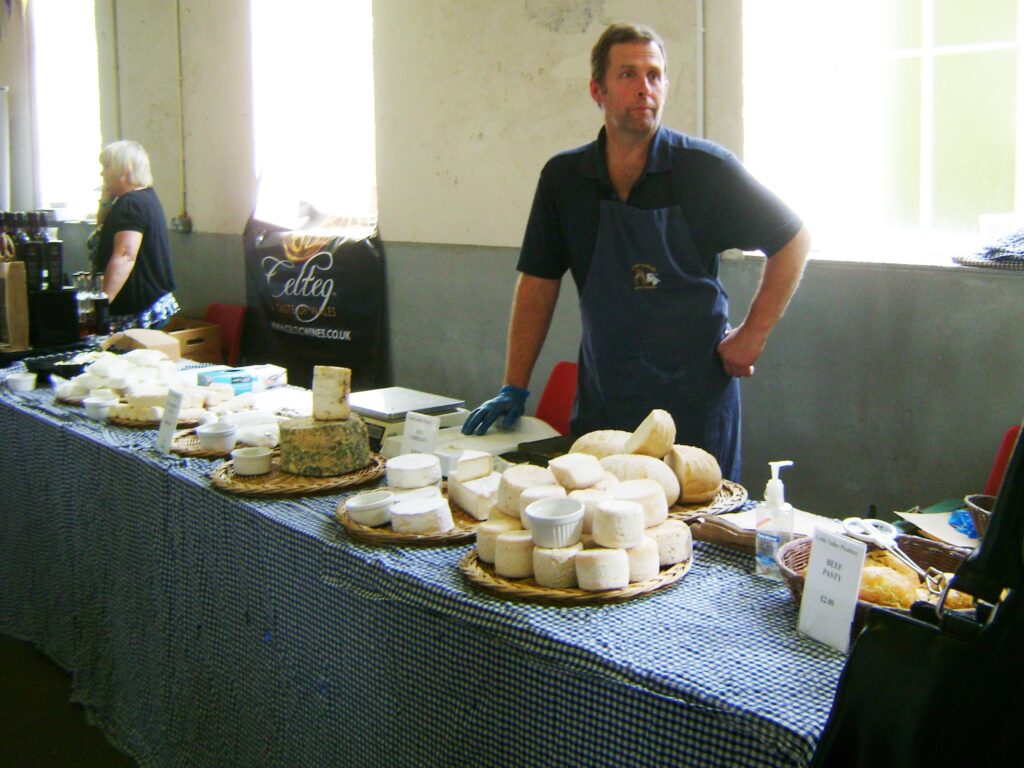
Ar yr un pryd, roedd nifer o bobl o’r tu hwnt wedi cyrraedd yr ardal yn awyddus i ffermio ar raddfa fach. Un o’r rhai mwyaf adnabyddus oedd John Seymour (https://en.wikipedia.org/wiki/John_Seymour), a brynodd fferm yng Nghilgwyn ger Brynberian, ac a aeth ati i ymarfer hunanddigonedd. Cyhoeddodd ei lyfr cyntaf, The Complete Guide to Self-sufficiency, yn 1978 ac roedd yn ddylanwadol iawn yn lleol ac yn ehangach.
Yn dilyn ei fenter a’i ddulliau arloesol, daeth ffrwd fechan o bobl eraill i chwilio am ‘ddulliau amgen’ a ffordd newydd o fynd i’r afael â bywyd a oedd yn cynnwys tyfu eu bwyd eu hunain. Roedd y rhain yn cynnwys yr Orbachs ym Mrithdir Mawr, Cilgwyn (https://brithdirmawr.co.uk), a oedd yn ymarfer permaddiwylliant; ynghyd â thechnegau amrywiol tebyg i ‘gerddi fforest’, fel y’u gwelir ym mhentref Llamas (https://lammas.org.uk/en/welcome-to-lammas/).
Nid oedd y garddwriaethwyr bach, hunangynhaliol hyn yn cytuno â chyflwyno organeddau a addaswyd yn enetig (GMO), ynghyd â’r arfer o ddefnyddio chwynladdwyr a phlaladdwyr wrth amaethu, ac maent yn parhau i wrthwynebu’r rhain. Mae dadleuon parhaus wedi bod ynghylch y materion hyn ac maent wedi cyrraedd lefel genedlaethol wrth i Lywodraeth Cymru, o’r diwedd, alw am gwtogi ar eu defnydd, gan annog ffermio organig. (https://www.gmfreecymru.org.uk/news/Press_Notice22Jan2013.html).
2000-2020
Yn y mileniwm newydd, bu newidiadau pellach i fwyd yng ngorllewin Cymru.
Yn y trefi, parhaodd yr archfarchnadoedd i dyfu mewn niferoedd a maint, ac o ganlyniad caewyd siopau bwyd bychain. Daeth yr anogaeth i ‘brynu’n lleol’ yn fwy amlwg a dechreuodd rai archfarchnadoedd werthu cynnyrch o’r fath ar eu silffoedd. Llwyddodd marchnadoedd hirsefydlog tebyg i Abergwaun (sy’n cynnal dwy farchnad yr wythnos) ac Aberteifi (<https://www.cardigan-guildhall-market.co.uk/>) i ddal ati, a sefydlwyd rhai marchnadoedd newydd hefyd, er enghraifft marchnad Trefdraeth.
Arweiniodd twf y diwydiant twristiaeth a lletygarwch at alw cynyddol am fwydydd lleol o safon uchel, a rhoddwyd pwyslais mawr ar y brandio, er enghraifft: Cig Oen Cymru, Cawsiau Cymreig, Eog Cymreig, Siocled o Gymru a llawer mwy, a hynny gyda chymorth o gronfeydd Llywodraeth Cymru a’r Undeb Ewropeaidd. Mae’r bwydydd hyn hefyd yn cael eu hallforio i farchnadoedd cenedlaethol a rhyngwladol, er nad yw eu prisiau bob amser yn fforddiadwy i bobl leol.
Sefydlwyd nifer o wyliau bwyd mewn trefi a phentrefi cyfagos, gan gynnwys Gŵyl Afon a Bwyd Aberteifi (http://www.cardigan-food-festival.co.uk/) a Gŵyl Fwyd y Frenni yng Nghrymych a sefydlwyd ar droad y ganrif newydd: (http://healthfoodswales.co.uk/blog/2011/08/gwyl-fwyd-a-chrefft-y-frenni-food-and-craft-fair-festival-2011-west-wales/). Mae’r ddwy ŵyl hon yn denu nifer mawr o dwristiaid a phobl leol. (dolen i’r lluniau)

Er bod y broses o gynhyrchu, dosbarthu a bwyta bwyd wedi newid tipyn dros y cyfnod o 75 mlynedd dan sylw, mae yna agweddau pwysig sy’n parhau, ac maent fwyaf amlwg yn y sioeau a’r ffeiriau garddwriaethol ac amaethyddol blynyddol yn ystod yr haf. Yn y rhain, fe welwch amrywiaeth o lysiau a ffrwythau a dyfwyd gartref, ynghyd â bara, chacennau, jamiau a diodydd cartref. (Cliciwch yma am luniau o Sioe Arddwriaethol Brynberian, Sioe Nanhyfer, Gŵyl Fwyd a Chrefft y Frenni a Gŵyl Fwyd ac Afon Aberteifi dros gyfnod o 40 mlynedd.)
(Cliciwch yma am enghreifftiau o gynhyrchwyr bwyd lleol, ynghyd â dolenni i gysylltu â nhw i archebu)
Bwyd mewn cyd-destun cymdeithasol
Mae bwyd yn parhau i roi cipolwg pwysig ar gymunedau, diwylliant a hunaniaeth pobl. Enghraifft dda oedd yr hyn a ddigwyddodd yn ddiweddar ym Mrynberian yn ystod y cyfnod clo. Cynigiodd un o’r pentrefwyr i helpu pobl i siopa yn Aberteifi, sef y dref agosaf, ac yn y pendraw, bu’n siopa ar gyfer 12-14 o bobl:
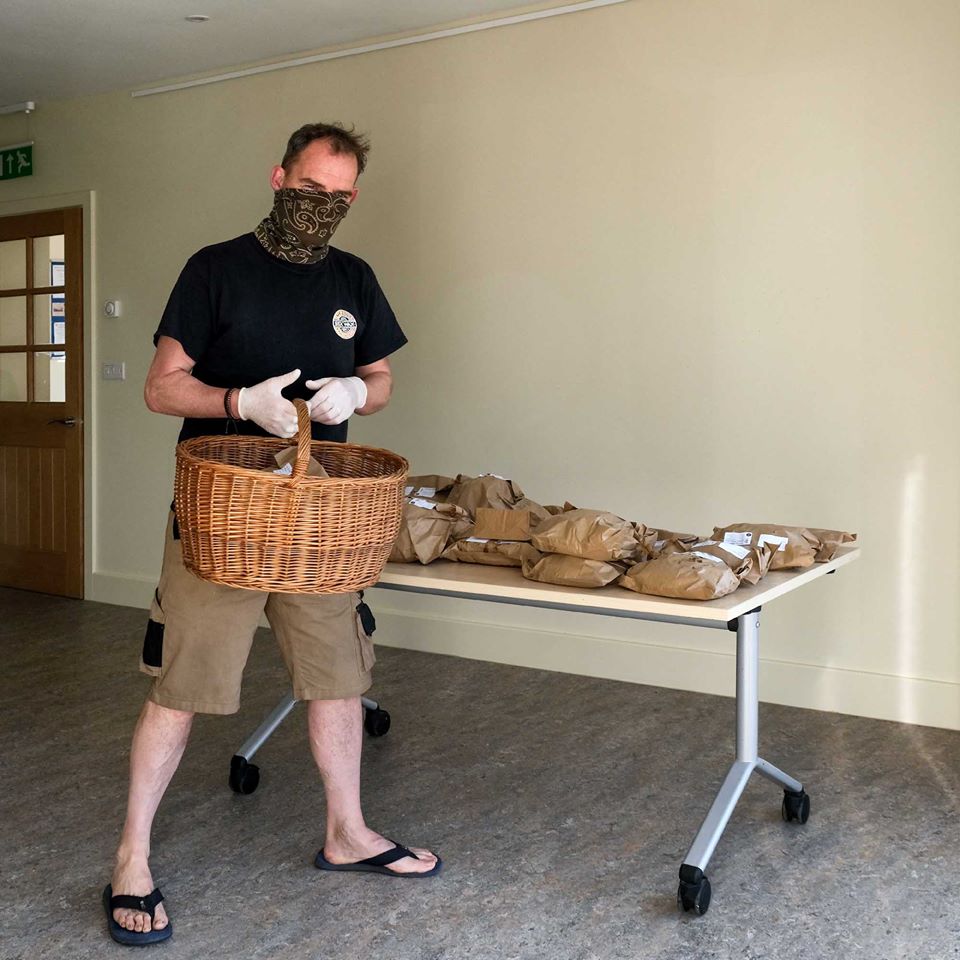
“They would email or text me by noon of my shopping day and I would go to Cardigan at 1 pm. At first it was very time-consuming because I did not know one of the two supermarkets I used and because some people wanted items I had never heard of!
I started off by delivering to each house, but that took a long time because here in Brynberian you can’t just drop and go, you have to have a conversation. So we started a collection system at the village Community Centre – I would text people when leaving Cardigan.
The Centre Coordinator also arranged for local traders to bring orders they had received to the Community Centre for collection. They were pleased to do this rather than having to go round the houses and farms in this dispersed village.”
Darllen pellach:
Bobby Freeman First Catch your peacock, Y Lolfa Cyf, 1996 [1980]
Gilli Davies, Tastes of Wales. BBC books 199
- Thomas and A. Hebbert (eds.) A Taste of Wales Wales Tourist Board 1989
Colin Pressdee, Welsh Coastal Cookery 1995, BBC Book
Peter Heard, Rachel Heard and Jane Corder. Dining with Angels. Bluestone Books 1994
Minwell Tibbott. Welsh Fare. National Folk Museum of Wales 1991
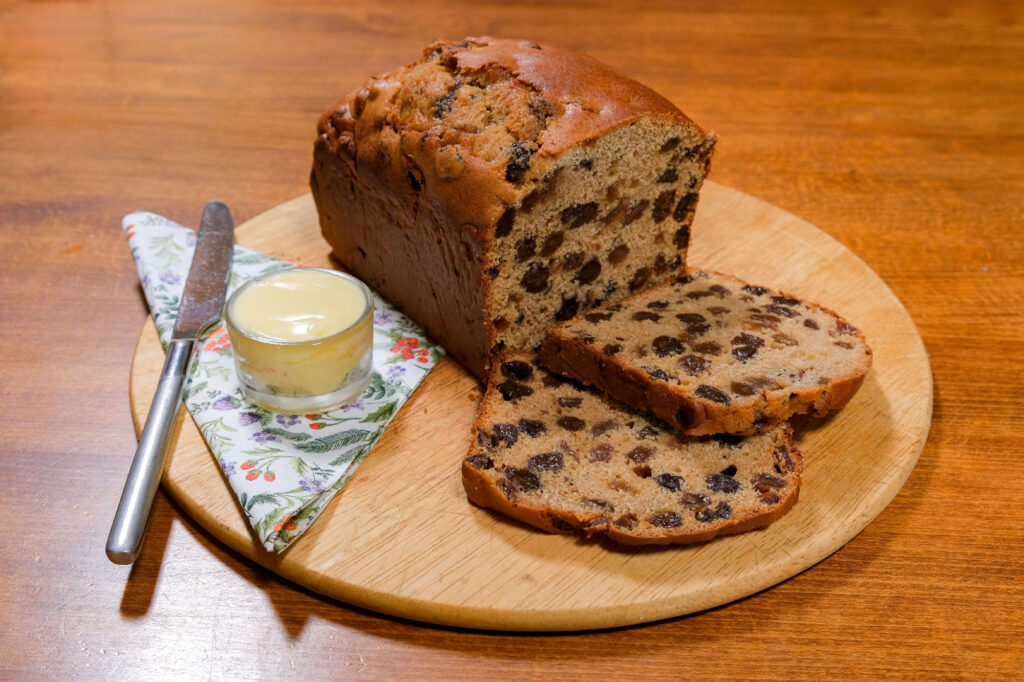
Extracts from interviews carried out in 1994-6 by Dr. Janice Williams, Research Associate on the ESRC-funded ‘Concepts of Healthy Eating’ research project. Both interviews were conducted originally in Welsh and both informants were in their sixties
1995 Interview with Gordon Thomas, a Brynberian farmer, which includes information on making macsi, a local brew
Because I was the baby at home then I used to have to help with making the butter and killing the pig and making cheese and I had to make ‘macsi’ of course. More than likely the others perhaps had got too big and I had to toe the line and milk at home and separate the milk and make butter – well, help to make the butter then and the cheese, so you know, and helping to make macsi so that’s where I learnt to make macsi.
And there’s a film of that?
Yes, that’s a St Fagans job. They went up to the other place we have in Brynberian to see the old way of making it…. We used all the old things, well they’re still here now. The ‘badell bres’ (brass pan) is still here now, we’ve still got everything.
Because there is a lot of things involved in the macsi ‑ not the modern way. I mean, using maximalt it is very easy to do ‑ but I’m talking now of the barley having been cracked and out of that I used to do it, see, back in the old days. We’d go up to fetch gorse to put around the tap, as a sieve, you see. But we did it then in that house (of his wife’s family) because all the old ‘fainc’ [slabs] were there.
When did you drink the macsi at home then? On what kinds of social occasions?
Oh shearing, hay time, or say somebody called. Then you see, well you’re going back a few years now when we were all Welsh-speaking people in the neighbourhood, it was nothing for you to have two or three come down at night and perhaps sit out on the hedge or in the house with a flagon. And perhaps then two nights later, you’d go up to them and they would have brewed too. It was a social thing too, you didn’t go down to the pub – you went to someone’s house – and there was no television, you know what I mean. And then hay time it was a big thing. Well, I mean you couldn’t cut hay unless you’d brewed first. Macsi first, cut hay after and then shearing and things like that. Everything we did, any big event, then we’d make macsi. Well I’m sure I used to macsi every three weeks or even more then, must be.
We’d keep the yeast then or malt in English or, what did we call it? ‑ ‘berem’ ‑ we’d keep it from one brewing to the next. And I was brewing this week and somebody else was brewing next week, he’d have a loan of this then and he’d bring back a pot to me then, you see. And this was going around the area. It kept it alive then. Yes, it went around the area and it was kept fresh then. And when the time of year came that there wasn’t so much macsi going on then you’d keep it somewhere cool, like in a ‘rhiwyn dwr’ (running water/stream). Until the fridges came in and then you kept in the fridge of course and took it out for about a day and then it would start working again. Then Christmas time everybody would macsi ‑ Christmas time and the New Year. “
How big was the area that did macsi?
Oh, everybody did it. Well every farm anyway, it was this area and down in Cwm Gwaun that was noted. In Brynberian and at home now the only ‘brag’ (malt) which was [considered] any good was with Dewi Pantygraig ‑ well with his father anyway ‑ and we had to go up to Pantygraig to fetch brag, you know. There was ‘brag’ in Newport ‑ there was a co‑op there, but that wasn’t good enough – we had to go up to Dewi’s father. He used to get it from somewhere special and I must say it was good brag too.
Brag is the barm then?
No, it’s the corn that you make beer out of ‑ brag they called that you see. It was barley that had just been split and dried in an oven and the more it had been dried, the redder the beer. If the beer was whitish-looking then it was said that this was not very good brag. If it didn’t run through the tap red in the beginning it used to be said, ‘Oh there’s not much about this old brag today’.
Then there was tablen fain (weak beer) they called it and it would be that beer that they’d have then when the hay would be coming in. It was the thin beer that would come out first.
Well I’ve been thinking, surely they’d get drunk?
No, well you see everyone was helping with the hay then, see, and the thin beer would come out then all day so that they wouldn’t get too drunk, but when the last load would come in, the strong beer would come out! Yes, I remember us at home bringing in the hay, and we only had two acres, and there were 23 men bringing in the hay. Dablen swrs (very drunk) going home. I remember one boy lying in the river going down past our house. We’d lost the bloke and he was in the river. He was home in bed, he said!
See short film on making macsi, courtesy of the National Museum of Wales, St. Fagans
Extracts from 1995 interview with Doris Davies, a Brynberian farming woman
I was born in in Penlan in Brynberian and that’s where my mother and father farmed – a small farm of 40 acres with cows, pigs, sheep, chickens, turkeys, ducks. They had about 50 sheep at the beginning but they did away with the sheep when they started selling milk and concentrated more on the cows. I left home at 13 – I had an aunt and uncle farming in Eglwyswrw and they needed somebody to work – this was during the war of course – the war was just breaking out when I was 13 and they wanted cheap labour, I think. There wouldn’t be a need for me to go to school so they asked that I be sent there working for just my keep at that time.
But the Attendance Officer found out and I had to go for the year to the school at Eglwyswrw but I had to milk and do everything before going to school, come home for cinio (dinner mid-day), wash the cinio dishes. It was a mile from the school, so walk home for dinner, wash the dishes, then go back to school. Then go home and do the milking – by hand then of course. I was there for 4 years.
My mother and father both became ill then at the same time. They needed somebody to farm at home and do all the work. They felt I was stronger than my sister who was two years younger than me – so I went home and my sister went to Eglwyswrw in my place then.
So I farmed at home then – by that time then they were selling milk and of course I had to catch the mare and saddle her up with the cart and go down with the milk to the stand [for the milk churns] at Brynberian school, no lorries would be going round. A large mare you know – not a pony and trap, lift the churns to the cart and take them down.
We were six children, my brother was the youngest, the eldest was much older. She was a half-sister and she was married by the time we were children. There were two sisters who were older than me who went to the County School in Cardigan – then me – then two younger sisters and my brother. I wasn’t allowed to go to the County School because they couldn’t afford it. I passed the exams – but there were two siblings there already and they had to stay in lodgings at that time you see.
During the period of ‘gwasnaethu’ with my uncle and aunt, the first year they just gave me my keep – the second year- I was 14 then – 5 shillings a week – the third year, 9 shillings and then I had a pound the fourth year so I got £52 a year the fourth year. [laughs] They had two married children. My aunt was my mother’s sister and she was quite a bit older than mam.
At that time did the women do everything for the men?
Yes everything – polished their shoes, then on Sunday if they had been to chapel – brush their suits, put them away and clean the shoes and shine them in case they were needed again of course.
After getting married I was living in a little cottage in Brynberian for the first year and then we took on a farm in Brynberian and ran it for 30 years.
What stood out in your memory as far as food was concerned?
When we were children you know there were only ‘tn cwlwm’ – culm fires. Once a week we used to bake – there was a big oven in the wall then you know and we lit a fire to bake – well that was the only time when we had – say mam would bake a tart or a bit of cake or something – but apart from that, everything we had it was done on the fire. Once a week we had ‘pwdin reis wedi ferwi’ [rice pudding boiled] – not in the oven. We slaughtered a pig but apart from that the only meat we had was a little bit of meat from the butcher to roast but not at all often – but it was all either boiled meat or fried meat – cawl.
Did you ever eat lamb?
Oh yes – mutton – but we would boil that – and chickens [fowlyn] – not chickens – but you know after the hens stopped laying, we would boil the hen – a broiler – it was not roasted unless we happened to do it when the oven was lit.
I don’t enjoy cooking myself, I haven’t got an interest in it – but you know I had to do it but I had no real interest in trying new dishes. There were rabbits of course – we trapped rabbits at the time – ‘cig moch’ [literally, pig meat] and we had eggs – either hen eggs or duck eggs. And we boiled the hens or the old cockerels then – but we kept the turkeys and we had a roast turkey at Christmastime – mam would always light the oven for Christmas. And every fai, Daddy would bring a box of bloaters – a wooden box full of smoked herrings and we would cook those on the bars on the fire on the flame – that was a big treat to have those fish.
I used to bake bread and make butter – I used white flour to make the bread – this didn’t come from a local mill. We shopped at the shop in Brynberian. Vans also made grocery deliveries. I made ‘bara planc’ – I used to make it on the farm sometimes. We ate it straight off the fire as a rule the same day as I baked it – because I used the same dough. It was a case of rolling it out flat and putting it on the griddle on the culm fire again.
How often did you used to have cawl?
Oh several times a week – when we were children – you know that was the ‘pryd’ [literally, meal] – and then we had cawl twymo [heated up cawl] the day after that – bacon and egg perhaps occasionally then… We slaughtered our own pigs and sheep – my father did this, not the pig – but he did the sheep. There was a butcher down the road – he was a mason – and he would come to slaughter the pigs – and we would make faggots and everything then you know – we would use everything from the pig – and brawn.
I made macsi myself – I know how to make it now but haven’t made it for years. We just made it for Christmas and for the harvesting of the hay – it wasn’t made all year round you know, although more often than not it was available in the house – you know it did last. It was Daddy who would make the macsi at home – of course then I didn’t know how but later I made it on our own farm. It was always Daddy at home, not Mam and he used a ‘padell bres wedyn’ (a brass bowl), he would light a fire outside and bring out the ‘padell bres’ at macsi time – it was a big day.
As far as today’s food is concerned you know all the ‘sn sy’ [hearsay] is that you’re not supposed to eat sugar, salt is bad for you – you know a lot of things are bad for you. I haven’t stopped eating anything because I enjoy salt – I put salt in everything – in custard – a pinch of salt – it brings out the flavour – and in everything the salt is a must – and I like a bit of salt in everything. I know I’ve got asthma and things now but I don’t believe in all this [healthy eating]- you know that different things are bad for you. If I like something, I’ll eat it.
If it was wet and very cold in the winter – it was quite a way to walk down to school – mam always used to give us an egg and milk – beat up the egg with hot milk – and I think she put a bit of ginger with it – a bit of sugar, a pinch of salt – and we would drink it – you were supposed to be healthy then to go to school. We always used to have that in the winter before we set out. We had breakfast – you know – it was bread and butter and cheese that we ate – apart from Quaker Oats – it wasn’t porridge in those days – it was Quaker Oats – but I must have been about 10 or 11 before I tasted tea or coffee – it was ‘llath enwyn’ [buttermilk] that we drank – for breakfast, dinner, tea and supper. I was the only one of all the children who refused tea or coffee – it was only buttermilk that I wanted .
What was the pattern of eating on a farm?
You got up in the morning and go out to do the milking. Perhaps you won’t have much before going out and then you come in and you have a big breakfast – and then you have dinner at mid-day but perhaps you won’t have much for supper.
At mid-day we had meat and potatoes. When we ourselves were farming there was a gas or electric stove and you could roast or whatever so there was a bit more variety.
And in the evening what did you tend to have then?
Sometimes potatoes again with something different – you know perhaps we’d have potatoes twice a day – perhaps a sausage then but ‘cinio’ [dinner] was more of a meal than the evening meal in a way at that time – more than now.
But you were used to cooking for an army weren’t you?
Oh yes, even though I had no real interest as I said but when it was ploughing or hay harvesting time perhaps we would have twenty people to feed you know. When we harvested hay all the neighbours and family would help out and we reciprocated. We often went up to other farms to help the wives to make lunch then, to help out with the food.
What did you tend to give them at hay time?
We had cawl at hay harvest time because the cabbage was fresh and nice by that time – ‘dalen wen’ [literally, white leaf] in cawl was a big thing. It was called ‘cawl fein’ [literally, nice, lovely cawl] at hay time. It was at dinner[lunch] time (‘amser cinio’) you had that then. Ffor supper then you had bread and butter, and cheese and cake, and buns at teatime but it was always cawl at lunchtime. A lot of people said ‘Oh we shouldn’t eat this now – we’ll feel too full to do anything but that was the ‘trefn’ [literally, order, rule -in other words, convention]
I’m surprised because I associate cawl with wintertime?
No cawl at hay time was a ‘peth mawr’ [big thing, important].
Although it was hard work, it was a lot of fun and it bound everyone together – everybody helped each another. It has changed now. No one now is concerned about you – and the hay – and whether you get it in – everyone for himself. I know it’s easier with the machinery but on the other hand I don’t know if it is that much easier.
Was there any bartering?
Yes, well at the time when you slaughtered a pig, you see – you’d call the meat that you cut off ‘fry’ – well that all went to all the neighbours. If you killed a pig you would take fry to the neighbouring farms, then when they slaughtered a pig you’d have it back. It wasn’t a must that they did so – perhaps they wouldn’t have a pig – but they would still be given – you wouldn’t give just for the sake of getting back.
How many pigs did you have?
There wasn’t any rule – when we had piglets we would sell them. We would slaughter about two pigs a year – and that would last the whole year – up in the big chimney then to be smoked.
Do you think food in the old days was healthier than it is nowadays?
I wouldn’t be surprised – our food was very plain you know – a lot of fat and things on the meat I admit but I don’t feel it’s done us any harm – the bacon was much nicer than what you get nowadays – it had taste.
Are there any things you can’t get these days that you would like to have?
The bacon as it was then. It is on the market sometimes – and I feel sometimes I’d like to rear a pig and slaughter it and salt it myself. When we salted a pig – I don’t know if there was any truth in it – if it happened to be at the time of the month when we had a period you know – Tadcu (Grandfather), that is my husband’s father, my father-in-law -he was adamant that a woman should not salt the pig at that time. A pig wouldn’t take the salt if we happened to be at that time of the month. The men would do the salting – it was Tadcu who always did the salting then.
How did you learn how to cook?
Well I didn’t learn – only watched, I could bake, roast and could make butter because I watched mother making it. Mother made Welsh cakes and had a bakestone [planc] on the culm fire.
Did she make bara brith?
Well it was only plain things mam made – it was only at Christmas time that she would make something a bit richer you know – she would make a cake or something. If there were left-over potatoes she’d make a potato cake then. You mash up the potato and then you added fruit, say sultanas or currants, milk and butter and a fistful of flour as well and then we put it in a tin in the oven. You would eat it like a slice of cake or perhaps after cinio [mid-day meal] as a pudding you know – similar to bara brith but made with potatoes.
In the old days do you think men were given different food compared with women?
No but the women tended to give them far more on their plates than they put for themselves – it was as if they felt that the man needed more than the woman – they would starve themselves to give to the men. Daddy was perhaps different from everybody else as he’d prepare his own food. He would go out to collect eggs – perhaps there would be two duck eggs and a basinful of bara te – cheese whatever – he would cut sandwiches to take with him to work. And that was exceptional at that time – going back now over half a century – and not many men would do that but he would have prepared his own sandwiches.
So he could do some things anyway – do you think that men could cook some things then?
I was lucky – my husband did as well as me. He could cook things like ‘cigach’ (meat things). I wasn’t afraid to leave him on his own – he wouldn’t starve. He could roast and boil a potato perfectly well – and as I say there weren’t many – especially the men on the farms – they weren’t used to cooking. The men on farms were spoilt almost more than other people because it was the wife in the house and the men were outside.
But young Welsh men are quite prepared to cook aren’t they?
Now yes – well my son prepares the Sunday dinner and everything there – his wife she can cook but she’s in school all day and more than likely the meal will be ready by the time they get home.
